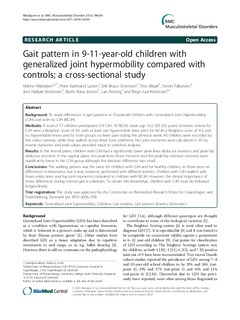| dc.description.abstract | Background To study differences in gait patterns in 10-year-old children with Generalized Joint Hypermobility (GJH) and with no GJH (NGJH). Methods A total of 37 children participated (19 GJH, 18 NGJH, mean age 10.2 (SD 0.5) years). Inclusion criteria for GJH were a Beighton score of ≥5, with at least one hypermobile knee joint; for NGJH a Beighton score of ≤4, and no hypermobile knees and for both groups no knee pain during the previous week. All children were recorded by five video cameras, while they walked across three force platforms. Net joint moments were calculated in 3D by inverse dynamics and peak values provided input to statistical analyses. Results In the frontal plane, children with GJH had a significantly lower peak knee abductor moment and peak hip abductor moment. In the sagittal plane, the peak knee flexor moment and the peak hip extensor moment were significantly lower in the GJH group although the absolute difference was small. Conclusions The walking pattern was the same for children with GJH and for healthy children, as there were no differences in kinematics, but it was, however, performed with different kinetics. Children with GJH walked with lower ankle, knee and hip joint moments compared to children with NGJH. However, the clinical importance of these differences during normal gait is unknown. To obtain this knowledge, children with GJH must be followed longitudinally | en_US |
